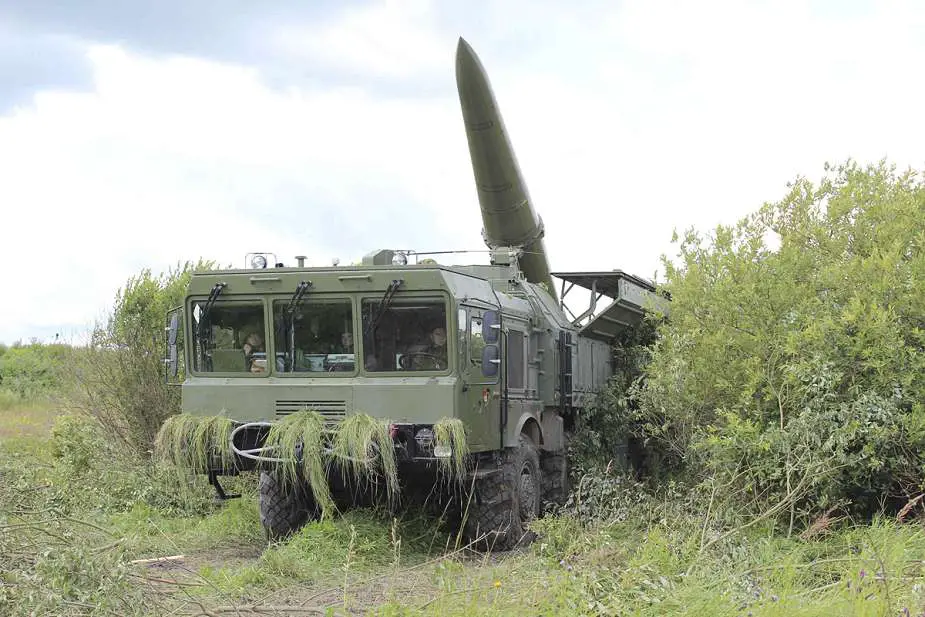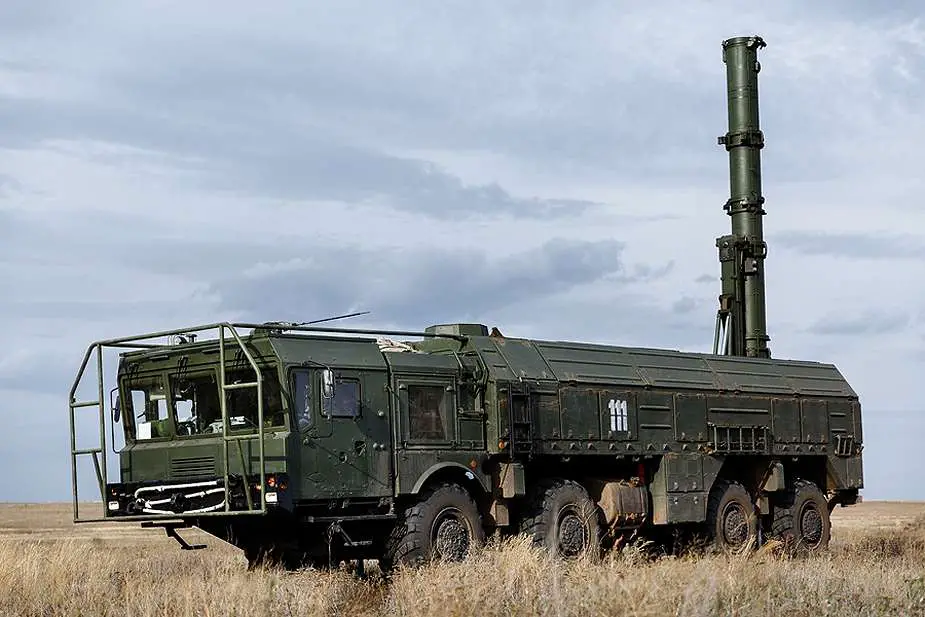In a recent interview with the Ukrainian Press Agency "Interfax," Major General Vadym Skibitskyi, Deputy Head of Ukraine's HUR Main Intelligence Directorate, disclosed a significant escalation along the Ukraine-Russia border. According to Skibitskyi, Russia has ramped up its deployment of Iskander mobile ballistic missile systems, positioning a total of 48 launchers close to Ukraine. This marks an increase of two additional Iskander launchers since September 2023.
Follow Army Recognition on Google News at this link

Russia reportedly deploys 48 Iskander ballistic missile launchers along the border with Ukraine. (Picture source Russian MoD)
Russian forces have intensified their aerial campaign against Ukraine in recent weeks, unleashing a barrage of cruise missiles and drones across multiple regions. These strikes have targeted a wide range of sites, including critical infrastructure, residential areas, and military facilities, underscoring a strategic shift in Moscow's approach to the conflict. The increased use of sophisticated cruise missiles, renowned for their precision and long-range capabilities, highlights a deliberate attempt to cripple Ukraine's defenses and sow chaos.
One notable instance of these attacks involved Russia deploying several Kinzhal hypersonic missiles to strike the Ukrainian capital, Kyiv. Despite the Ukrainian Air Force's efforts, which reportedly intercepted all 10 Kinzhal missiles, the attacks resulted in casualties and significant damage. The aerial assault targeted both Kyiv and the eastern city of Kharkiv, with Russia firing a total of 99 rockets and cruise missiles of various types. This bombardment led to over 90 people being injured and the deployment of more than 500 rescue workers. The Ukrainian Air Force's ability to intercept 72 of these missiles underscores the ongoing battle for air superiority and the effectiveness of Ukraine's air defense systems.
The recent escalation in Russian missile and drone attacks is reportedly stretching Ukraine's air defense resources to their limits. A Ukrainian Air Force official highlighted the country's vulnerability due to this escalation, indicating a pressing need for further weapons supplies to maintain their defensive capabilities. This surge in attacks utilizes a diverse array of missiles, aiming to overwhelm and find gaps in Ukraine's air defenses. The attacks not only target military objectives but also strain Ukraine's weapon stockpiles, which consist of both Soviet-era weapons and modern systems provided by Western allies. The Ukrainian authorities are seeking to enhance their own weapons manufacturing capabilities to reduce dependence on external supplies, particularly for guided air defense missiles.
In the ongoing conflict between Russia and Ukraine, the Iskander missile system has emerged as a critical asset for Moscow, offering a potent blend of tactical flexibility and precision striking capability. This advanced missile platform is engineered to carry out high-precision strikes over a range of up to 400 kilometers, depending on the variant, allowing Russian forces to target strategic military installations, critical infrastructure, and troop concentrations with remarkable accuracy.
The Iskander missile system, developed by Russia, represents a family of short-range, mobile ballistic missile systems that stand out for their versatility and advanced technological design. Central to this family are two primary variants: the Iskander-M, which is deployed by the Russian military, and the Iskander-E, an export version with slightly reduced capabilities. The Iskander system is engineered to replace older Soviet-era tactical missile systems, offering a significant upgrade in terms of range, precision, and operational flexibility. Capable of carrying conventional or nuclear warheads, the Iskander missiles boast a range of approximately 500 kilometers for the Iskander-M and about 280 kilometers for the Iskander-E. This system is renowned for its ability to evade missile defense systems through its maneuverable reentry vehicle (MRV), which can alter its flight path to avoid interception, and its quasi-ballistic flight trajectory, further complicating defense efforts against it.
In combat, the Iskander missile system's capabilities allow for highly effective precision strikes against key enemy targets, including military installations, command and control centers, and critical infrastructure. Its high mobility, derived from being mounted on a road-mobile launcher, enables rapid deployment and repositioning, significantly reducing the window for enemy counteraction. The system's state-of-the-art guidance technology, incorporating inertial navigation supplemented by satellite guidance, ensures that the Iskander can engage targets with high accuracy, minimizing collateral damage and maximizing the strategic impact of each strike. The versatility of the Iskander system, capable of firing a range of missile types and equipped with sophisticated electronic warfare packages, makes it a formidable tool in modern warfare, enhancing the tactical and operational capabilities of the forces that deploy it.

The Iskander-K is a Russian-made cruise missile system, renowned for its low-altitude flight and precision strike capabilities. (Picture source Russian MoD)
The Iskander-K variant diversifies the operational capabilities of the Iskander family by incorporating the use of cruise missiles, particularly the R-500, a derivative of the 3M14 Kalibr cruise missile, known for its versatility and effectiveness. The Iskander-K has a reported range of up to approximately 500 kilometers, matching the ballistic missile variant in terms of reach. This range allows for strategic targets well within enemy territory to be engaged with high precision, making it a formidable asset in Russia's military strategy.
One of the main features of the Iskander-K is its ability to launch cruise missiles that can fly at extremely low altitudes, reducing their visibility to radar and increasing their chances of evading enemy air defenses. The cruise missiles employed by the Iskander-K are capable of carrying conventional warheads, making them suitable for a wide range of tactical and strategic missions, including striking against fortified positions, command centers, and critical infrastructure with minimal collateral damage. The Iskander-K's flexibility in mission profiles, coupled with its high mobility and rapid deployment capability, ensures that it can respond quickly to changing battlefield conditions and engage a variety of target types with precision. This adaptability, combined with the system's advanced guidance and navigation systems, solidifies the Iskander-K's role as a critical component of modern warfare, enhancing the combat capabilities and strategic deterrence of the forces it serves.
News Russia Ukraine War
















